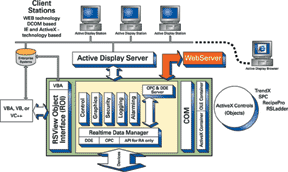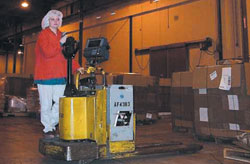Web Promotes Collaboration But ... How Soon?

CPFR --Collaborative Planning, Forecasting & Replenishment -- is one of the latest buzz terms emerging from the cyberspace of "e-commerce." The term means Internet-based cooperation between manufacturers, suppliers and customers to predict demand and assure adequate supply -- the "Holy Grail" of food manufacturing and marketing.
The Internet is here. But two key ingredients -- trusting relationships and well-developed standards -- are needed before food manufacturers can truly integrate with retail and foodservice customers across the supply chain, said William R. Friend, former vice-president of the J.R Simplot Food Group, at Food Engineering's recent Food Automation 2001 Conference in Fort Lauderdale, Fla. "Without a lot of trust, voluntary standards are going to be weak," added Friend, now principal of the consulting firm WR Friend & Associates, Boise, Idaho. "Uniform adoption of standards ... will probably not emanate from the food-manufacturing industry."
The changing nature of competition will change the way we look at information. "There will be increasing demand for customer-specific standards in both retail and foodservice," Friend predicted. "Supply-chain information integrated with customer strategies will be critical for competitive advantage."

Drivers & constraints
In the absence of trust, Friend observed, collaborative forecasting, planning and information will be driven by:
- Government regulations, including nutritional labeling, food-safety testing and trace/recall procedures;
- Changing business realities, characterized by giant consolidations in both manufacturing and retailing. Retailer consolidation puts continuing pressure on manufacturers to reduce capital, operating, inventory and supply-chain costs, and to shift from the traditional "push" strategy of manufacturing to inventory to a "pull" strategy of manufacturing to demand. Additional drivers include the need to improve order-fulfillment rates and longer shelf-life requirements to meet expanding radii of distribution.
- "Channel masters," the retail and foodservice giants such as Wal-Mart, McDonald's, Kroger and Albertson's, who will dictate the standards. McDonald's and Sysco, for example, have joined in a consortium called the EFS network. "When you compete against McDonald's, you're competing against their supply chain," said Friend. "Competition is developing between supply chains rather than between companies." The channel masters are driven by their need for standardized product specifications and thus standardized supply-chain information. Meeting the demand for standardized supply-chain information can create complexity for the multi-plant manufacturer, more so if he employs co-packers.
Food manufacturers are also constrained from supply-chain collaboration by their fragmented internal IT architecture -- stretching from data capture at the plant-floor device level up through HMI/SCADA, formula and batch management, MES, databases and ERP and finally to supply-chain applications. Atop this fragmented architecture, "are not just the exchanges and the Web portals we have to use, but the customer and supplier systems we have to interface with," Friend observed. "Integration is the key."
In the e-business model, Web-enabled forecast and product-movement information from customers is integrated with the plant's production capabilities, and production is optimized and prioritized based on plant capacity and customer orders. EAI (Enterprise Application Integration) software such as Microsoft BizTalk, Tibco, Vitria and WebMethods is emerging to integrate both the enterprise itself and the enterprise with B2B transactions, Friend reported. EAI software enables data and process to pass between complex applications.
To integrate the plant floor with the supply chain, Friend advised, manage integration as a change process and:
- Stick with the same operating systems and databases where possible. "If you can't be consistent, be compatible."
- Develop a plant-integration strategy. Consider data warehousing for internal and external user interfaces. Web-enable legacy output.
- Develop the capability to import ingredient information from suppliers and forecasting data from customers, and to export production information to customers and scheduling information to co-packers.
A cross-functional team incorporating purchasing, plant management, IT and marketing is needed to make the integrations, but leadership must come from the top and the plant must "morph" into a supply-chain module. "New business models based on the Web are changing the rules of competition," Friend concluded.
Technologies emerge
Although trust and customer-based standards will be needed, the technologies to achieve Web-enabled manufacturing are emerging. "The Web is transforming automation systems without engineers knowing it," reports Kevin Prouty, research director for manufacturing strategies at AMR Research, Boston. "When engineers weren't looking, companies like Rockwell Automation and Schneider Electric slipped Web servers into their PLCs."Every major HMI software vendor now has some form of browser-based viewing software, Prouty adds. With Web servers embedded into control hardware "a simple browser can replace most of the HMI functions."
Plants typically use software drivers, HMI systems and dedicated gateways to access and consolidate data at a relatively high cost, Prouty continues. This approach is not only costly but inflexible, and it leaves gaps in plant data. Web servers embedded into the control architecture, however, expose raw process data to the enterprise. "Engineers and IT personnel can work together to tap the data and fill-in gaps through inexpensive Web converters."
One hurdle to overcome, says Prouty, "is taking the fire hose of data and?collating it into usable information for analysis. Companies like IndX and Lighthammer Software are providing Web-based analysis packages that boil the data down to Key Performance Indicators (KPIs) for the end user."

Portal to the Web
The focus for integrating manufacturing information with the World Wide Web is the Web server, a computer which runs on software creating a portal accessible by anyone with a Web browser such as Microsoft Inernet Explorer or Netscape Navigator.Example: The Illuminator, a plant-information portal from Lighthammer Software Development (Exton, PA), which connects plant automation and information systems with the Web, allowing anyone in the internal or external supply chain to access real-time manufacturing information via browser.
Illuminator extracts plant-floor information, aggregates it, and converts it into data with a business context via an XML browser structure or "schema" such as Microsoft BizTalk or RosettaNet. (XML [Extensible Markup Language] is an emerging standard which makes that conversion possible.) Illuminator then distributes the data to "thin clients" -- client computers which need no resident software, only a browser.
"Connectors" enable users to "mine" information from a wide range of manufacturing technologies including Rockwell RSView, Siemens WinCC, Schneider FactoryCast, US Data FactoryLink, Citect, Wonderware, Intellution, Aspen, Microsoft SQL Server, Oracle and other data sources. Connectivity is non-intrusive, allowing integration with legacy systems without disrupting operations. According to Lighthammer, Illuminator can be installed and deployed "in hours."
With Illuminator, a corporate exec or engineer needs only a browser to access real-time plant data such as production planning, throughput, asset management, maintenance, engineering, SPC, etc. Customers with security clearance (via password or other authorization) can access selected manufacturing information via browser from the manufacturer's web page. Illuminator is currently applied in the brewing and confectionery industries.
As noted by AMR's Kevin Prouty, every major HMI vendor now has some form of browser-based software enabling integration with the Web.
Rockwell Automation's RSView32 WebServer, for example, allows a user to connect to an RSView32 HMI system from a thin client via browser to look into graphic displays, tags and alarms and update project data. The WebServer is installed only on RSView and requires no configuration in the client.
Foxboro last December introduced a Web-enabled Report Package for process manufacturers using its I/A Series workstations. The package allows users to build production reports which can ve viewed throughout the enterprise via browser on PCs, I/A Series workstations and thin clients.
Additional examples seen by Food Engineering at the National Manufacturing Week Show March 7 in Chicago:
- Wonderware's Terminal Services for its InTouch HMI system functions as the web portal for operator interface, allowing the plant manager or plant engineer to see what the operator is seeing via browser from his thin-client PC. Managers, customers and suppliers can access plant information with their thin-client browsers via Wonderware's SuiteVoyager, a web portal which aggregates manufacturing data and converts it to usable information using XML.
- Camstar's InSite e-manufacturng solution incorporates an Internet Access Web Server which delivers real-time production information throughout the plant, across the enterprise and out to the supply chain.
- National Instruments Lookout HMI/SCADA system incorporates a Web server which allows the operator to export the process to the Web, where it can be viewed and controlled from anywhere in the world by authorized users.
- Australia-based Ci Technologies (Citect) expanded its Plant2Business suite with Plant2Net, a data-warehousing and analysis solution which provides a "portal to the plant floor" allowing users to access and view plant information via Web browser.
- iFIX 2.5, Intellution's HMI/SCADA solution, extends the plant floor to remote locations by integrating thin clients and Web browsers with a Terminal Server, allowing users to access all the functionality of the server to remotely configure and visualize plant-floor applications.
SIDEBAR
Anchor Foods collaborates via WebAnchor Foods, a manufacturer of frozen heat-and-eat appetizers for food-service and retail markets in Appleton, Wis., shifted from forecast-based production to market-driven manufacturing assisted by a multifunctional Demand Management software package from systems integrator On-Point Consulting (Hudson, Ohio).
The package incorporates production planning and production scheduling functions; displays manufacturing, inventory, marketing, sales, accounting and service data by market segment; integrates via touch-screen MMIs with an IBM Plant Floor Solutions package and AS400 mainframe to execute production; traces ingredient and product by lot for quick response to recall if needed; integrates via radio frequency with MMI-equipped fork lifts which supply production lines with raw materials and packaging supplies; integrates via Web with suppliers for JIT deliveries of ingredients and materials; and will eventually integrate via Web with customers as well.
Inaccurate forecasts costly
"For years, we relied heavily on a monthly forecast for order planning that was inaccurate 50 percent of the time," says Pat Lovesee, Anchor's director of logistics and warehousing. "And much of the demand for our products was so erratic that we couldn't predict what the distribution pattern should be."
As a result, the plant would sometimes run out of raw materials and finished products and be unable to fill orders, or would have to expedite delivery of raw materials at premium freight charges that added to product cost. Suppliers were frustrated because they were often pressured to deliver beyond their capabilities. Anchor needed a new manufacturing strategy that could respond to changes in customer demand without incurring extra costs, yet accommodate the company's 15 to 20 percent annual growth rate.
Seven-phase analysis
On-Point Consulting implemented a seven-phase strategic business assessment which analyzed market segments, competition, customers, inventory, production capacity and throughput, information structure, and suppliers. In segmenting markets, the team found that about 80 percent of Anchor's business is in the food service segment, 15 percent in club stores and five percent in six other segments. The team thus concentrated on its two major markets.
The assessment also revealed that production planning was not coordinated with purchasing. Because they were unaware of planned production, Anchor's suppliers could not anticipate demand. "Because we utilized a forecast-driven manufacturing plan which was wrong half the time, we had to estimate our raw material demand, which required us to pad our inventory," says Craig Elonen, Anchor's analytical systems manager. "In addition, our ERP system was set-up so that if inventory dropped below a certain point, it would force demand on the plant."
Collaborative planning
One of the team's first moves was to discard the forecast system and let orders drive the production schedule. Demand Management software allows the plant to operate as a flow process, manufacturing related "families" of products, rather than a discrete process manufacturing individual items as mandated by the ERP system. It also enables Anchor to collectively plan with suppliers and correct inventory levels. "We now plan for the 80 percent of our production volume which is very predictable," says Lovesee. "The other 20 percent we make to stock, and we have a longer-term forecast to predict what our inventory plan should be for those items."
Elonen describes Demand Management as a SQL server-based client/server package incorporating four modules: Rough-Cut Capacity Planning; Cycle Planning; Rate-Mix Planning; and Supplier-Managed Inventory, "all interconnected so one feeds the other top-down and bottom-up," he adds. Designed as a "bolt-on" package to the JD Edwards ERP system, this structure allows looking at different levels of aggregation to correctly respond to customer demand. "It's basically allowed us to analyze changes in the forecast and orders over time," Elonen continues.
Demand Management incorporates a Web server which allows Anchor to make real-time updates to the production schedule on a daily basis, forecast changes on a weekly basis, and is accessible to suppliers in real time. The system also Web-enables Advance Shipping Notices (ASNs) to Anchor's warehouse and immediate feedback if a shipment does not match the ASN.
Looking for a reprint of this article?
From high-res PDFs to custom plaques, order your copy today!


